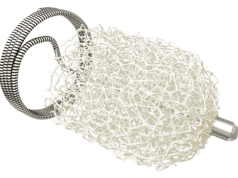
The US Food and Drug Administration (FDA)-approved Gore Excluder Thoracoabdominal Branch Endoprosthesis (TAMBE) has been shown to be safe and effective at 30 days for the treatment of patients with complex aortic aneurysms involving the visceral aorta.
This is according to findings of the TAMBE trial, a prospective non-randomised multicentre study investigating the use of the TAMBE device in thoracoabdominal and pararenal aortic patients, enrolled in the USA and Europe. Findings of the trial were presented at the 2024 Vascular Annual Meeting (VAM; 19–22 June, Chicago, USA) by Mark A Farber of the University of North Carolina in Chapel Hill, USA.
TAMBE is an implantable branched device designed for use in patients with thoracoabdominal aortic aneurysms (TAAA) and high-surgical risk patients with pararenal aortic aneurysms (PRAAs) of the aorta using an endovascular approach.
The device has four built-in pre-cannulated internal portals to facilitate placement of bridging stent grafts into the visceral arteries perfusing the internal organs within the abdomen. The US FDA granted approval for TAMBE to be used in the treatment of complex aneurysmal disease in January 2024, a move that was heralded by the device’s manufacturer Gore as paving the way for the first off-the-shelf solution in the USA.
Farber presented the first of two arms of the TAMBE trial, which targeted type IV TAAAs and PRAAs, including 102 patients in total. A secondary arm focused on Crawford type I-III aneurysms is continuing enrolment, having recruited 23 patients so far.
Patients enrolled in the primary arm of the trial had an average age of 73, were predominantly male (84%), and presented with significant cardiovascular risk factors including current smoking (42%) and hypertension (92%). Around 40% of patients were treated for PRAA, with around 60% treated for type IV TAAA, with 83% of the TAAA cohort and 72% of the pararenal group had an aneurysm diameter of >5.5cm.
Technical success of the procedure was achieved in all but one patient, Farber detailed, adding that there were no access failures, and 407 of the 408 target vessels were successfully stented. Non-TAMBE components were required to be placed in 19 patients.
Following their procedures, patients had a mean length of hospital stay of 4.9 days, with 89.2% of patients discharged to home. No lesion-related mortality or severe bowel ischemia were reported through 30 days.
Reinterventions were required in 9.4% of patients at 30 days, with one device-related death reported on post-operative day 39, which Farber commented was likely related to superior mesenteric artery (SMA) stent occlusion. Major adverse events occurred in 6.9% of patients, including two with respiratory failure, one disabling stroke, and two patients having developed new onset renal failure requiring dialysis. Two patients developed paraplegia.
The success of the trial was measured against two composite primary endpoints, one including technical success and procedural safety, and the second reinterventions and lesion-related mortality.
“Overall, 92% of the subjects were free from procedural safety events, however, the uncomplicated technical safety performance goal, 80%, was not met in the study because of the number of unplanned non-TAMBE devices implanted,” Farber detailed.
Patient selection is likely to have had a significant impact on outcomes, and device applicability may not reflect real-world experience, Farber said, outlining some potential limitations of the study.
“The TAMBE device has been shown to be safe and effective at 30 days at treating patients with complex aneurysms involving the visceral aorta,” said Farber. “Outcomes demonstrate a high technical success rate, no 30-day mortality, and a low rate of safety events within 30 days of the index procedure.”
However, he cautioned that the procedure is “not without risk”, citing the occurrence of paraplegia, renal failure, and a need for adjuvant stenting to resolve complications both intraoperatively and in follow-up.
“Long-term data will help determine where this treatment strategy will fit in the management of patients with TAAA and PRAA,” he said.













